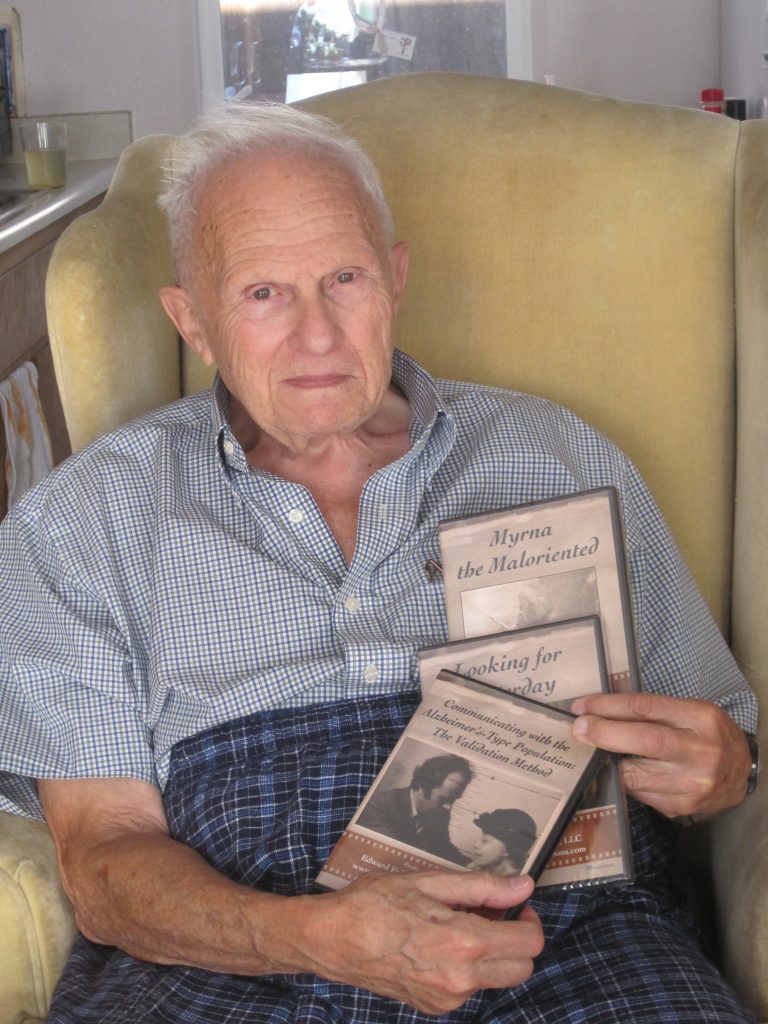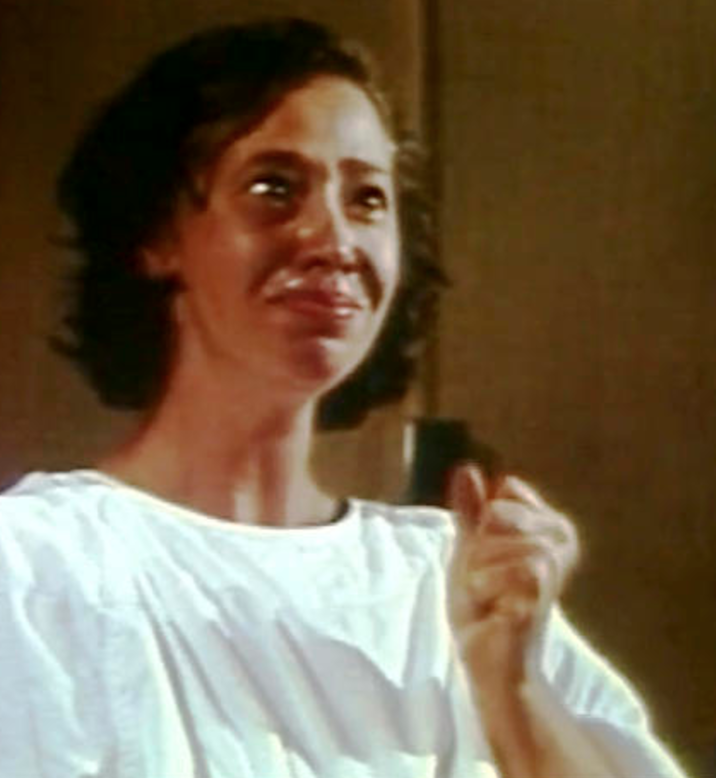The long-standing professional partnership between VTI founder Naomi Feil and her husband, retired filmmaker Ed Feil, has led to a slew of award-winning films in the fields of gerontology, education and human relations—and even a place in the National Film Registry. For Ed, filmmaking has always been a labor of love.
Last fall, the New York Times ran an article that detailed the story of a remarkable home movie, shot during the 1964 World’s Fair in New York City. This wasn’t just any home movie, though: the photographer ended up capturing a portion of the film “Think,” a film installation created for the World’s Fair that was thought to be lost to history forever. In addition to its content, the film was also unique because of its professional quality (in comparison to amateur efforts of the time).
So, what does this have to do with the Validation Training Institute, you ask? The cameraman was none other than Ed Feil, husband of Validation Training Institute founder Naomi Feil. To understand this story is to more fully comprehend the origins of VTI. That’s because over the course of several decades, Naomi and Ed teamed up to create multiple award-winning films that led to wider dissemination of Naomi’s vision.
“Ed’s films were really the start of everything,” Naomi says.
The 1964 home movie, described in the Times article, sheds some light on Ed’s passion for filmmaking and gives a glimpse into life in the Feil family.

“The World’s Fair film shows a woman taking in the sights with two little girls in tow — Mr. Feil’s wife, Naomi, and two daughters. There are shots of crowds moving, always moving, and of newfangled conveyances like moving sidewalks and moving chairs, which look like blue-black caterpillars inching toward the camera. Later, Mr. Feil catches a glimpse of a brand-new 1964 Chevrolet. In another shot, the U.S. Royal Ferris wheel, a giant tire that was the work of the architecture firm that designed the Empire State Building, whirls in the distance. There is no soundtrack, but it is easy to imagine the oohs and ahhs.”
While the Times story primarily focused on Ed’s connection with the “Think” film, it also highlighted the quality of Ed’s entire catalogue of work (both professional and home movies). For example, just four years after the Worlds’ Fair film was shot, Ed and Naomi’s 1968 film, “The Inner World of Aphasia,” was made. Two years ago, that film was inducted into the National Film Registry.
“Ed’s home movies are not your average home movies,” said Robert Anen, a graduate student at New York University’s Moving Image Archive, in the Times article. “Ed was a professional. His home movies are heavily stylized compared to your average home movie where someone is pointing the camera at a Christmas tree or taking it in the car with them or stuff like that. He’s got this built-in technique to make his footage entertaining even though it was a home movie.”
Recently, Robert exchanged e-mails with Naomi discussing other films that Ed helped create. Below are a few highlights of their conversation, and more insight into the early days of VTI. Enjoy!
From: Robert L Anen
To: Naomi Feil
Subject: Re: Question about your home movies.
Hi Naomi, Ed and Ken,
I’ve been watching your home movies lately and the edited travelogues from Denmark, Bermuda, Puerto Rico, etc are all stunning works. I’m curious about something, when I was selecting these to be digitized, back when I was interning at IULMIA, I noticed that these travelogues were composite prints, not merely was the original footage edited together but Ed sent the footage off to Film Lab to have a print struck. These travelogues tell stories, have an arc, etc.
Do you know why Ed did this? Was it solely for pleasure? Did his clients for Edward Feil Productions fund his trips to some of these countries and Ed made these travelogues as a gift? I’m really curious to find out.
– Robert
From: Naomi Feil
To: Robert L Anen
Subject: Re: Question about your home movies.
Hello Robert,
Ed felt so good when he read your email. He edited the travelogues because they gave him pleasure, and he felt that they had entertainment value. He was hoping to show them to people who might be interested in funding his trips.
Unfortunately, he never did show them. He did show them to family and friends, and we all enjoyed them.
It is so wonderful that, at age 92, his films have found a new light , and give pleasure to others. Thank you!
Have a wonderful holiday, and a year full of joy.
– Naomi and Ed
From: Robert L Anen
To: Naomi Feil
Subject: Re: Question about your home movies.
Hi Naomi,
That is so wonderful to hear! I believe Ed’s travelogues will serve as historical documents of many places for years to come. Home movies are being studied more than ever these days, in fact. It’s all a matter of getting the digitized travelogues out to the countries where they were initially shot.
Dan Streible dubbed me a “home movie whisperer” of sorts at the time I discovered the connection between the World’s Fair footage and Think. I like the title and will try do just that over the coming years.
On another note, yesterday, for the first time, I watched “Looking for Yesterday” via the Kanopy streaming service. Very moving, authentic, and educational. It’s fascinating to see the development of your Validation method beginning with “Where Life Still Means Living”. How did you come to the idea of incorporating your research into the scripts?
Happy Holidays!
– Robert
From: Naomi Feil
To: Robert L Anen
Subject: Re: Question about your home movies.
Hello Robert,
Or should I say, “Home Movie Whisperer”……a great title.
Glad you liked “Looking For Yesterday.” To answer your question, I grew up at Montefiore Home. My father was the director and we lived in the home. The residents were my friends, as I didn’t have many friends, having just moved to Cleveland. I knew the “old people” well, and began working with the disoriented people in 1963. I had written a number of articles about my work, and found, that when I entered their world, they began to talk. In 1972, “Reality Orientation” became the treatment for this population. This was the treatment proposed by a Psychiatrist, Dr. Folsom, director of a V.A. hospital in Alabama.
A journalist, who had come to observe my group, wrote: “Fantasy is an Arm for Therapy” at Montefiore Home. So, I called my work, “Fantasy Therapy.” I knew that directing the people to outside reality caused withdrawal inward, because I had tried it. Entering their world, built a successful relationship, and the people responded and became animated. I wanted to show the geriatric community that “Reality Orientation” had negative results with very old people who were disoriented and had entered their inner reality. So, I wrote the script for “Looking”, based on my knowledge of the people who were disoriented. Ed filmed my group meetings. Since my father was the director, the head nurse, who was forcing “Reality Orientation” on the people could not stop our filming.
The film was banned by the geriatric population, and I received a number of “hate letters”. A researcher from Benjamin Rose Institute in Cleveland, saw “Looking”, and told me that I was”Validating” the people, and shouldn’t use the word, “Fantasy” if I wanted the scientific community to research my method. So, after we filmed “Looking,” I changed the name to:”Validation.”
We made a number of films which may interest you: “100 Years to Live” documents three generations, and what happens when people are suddenly placed nursing homes. Hope this answers your question.
Thanks again for your insights. Happy Holidays!
– Naomi
